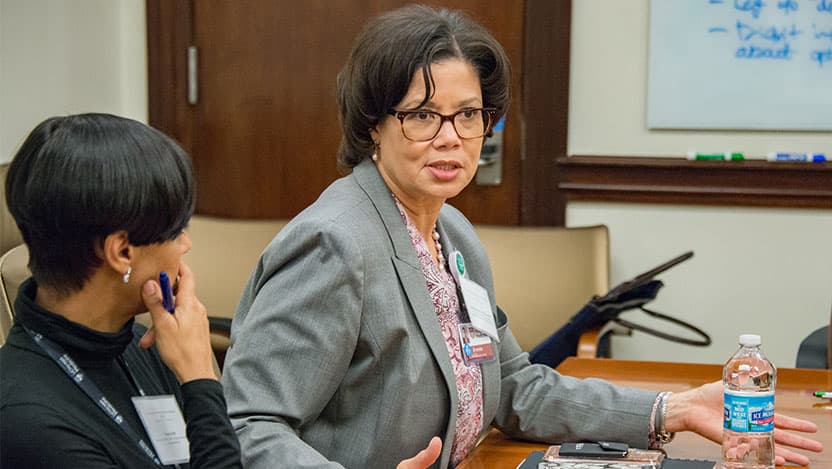Racism as a public health crisis

Brenda Battle, MBA, BSN, RN, Vice President of the University of Chicago Medicine’s Urban Health Initiative and Chief Diversity, Equity and Inclusion Officer
The COVID-19 pandemic highlighted the poor health outcomes and chronic disease that disproportionately affect African American and Latinx communities.
To tackle issues of racial and health inequities surrounding COVID-19 in Chicago, Mayor Lori Lightfoot convened the Racial Equity Rapid Response Team. The team includes Brenda Battle, MBA, BSN, RN, Vice President of the University of Chicago Medicine’s Urban Health Initiative and Chief Diversity, Equity and Inclusion Officer, and Monica Peek, MD, MPH, Associate Professor of Medicine and Associate Director, Chicago Center for Diabetes Translational Research.
Through this response team, a group of 45 healthcare organizations declared racism a public health crisis in an open letter to the community published in June, and pledged to adopt several measures to address inequities in healthcare.
You were both key to the effort that recently declared racism a public health crisis. What is the link between racism and health?
Brenda Battle: The healthcare industry in general has played a significant part in how communities have experienced health disparities, whether from the lack of access, bias in decisions that affect the lives of patients or uncoordinated and fragmented care delivery.
When you consider what health disparities refer to – differences in health between population groups – these reflect differences in access and quality of care. Our institutions have contributed to these disparities, which has led to increased burden of illness, injury or mortality in our communities. These are public health issues.
What we know is that groups of people have systematically experienced greater obstacles to health on the basis of their race, color, national origin and ethnic group. This experience is historically linked to discrimination or exclusion of groups that are vulnerable to health and healthcare disparities.
Monica Peek: Racism is a public health crisis because it is the underlying driver for the vast majority of health disparities in the U.S. Structural racism — differential access to goods and services based on race — and is made possible because of the policies, laws, norms and systems that we have in place. Access to safe housing, clean water, violence-free neighborhoods, strong educational systems, employment opportunities and yes, healthcare, all differ by race, with African Americans historically and contemporarily having less access. And all of these factors impact the health and well-being of people and the communities in which they live
Take diabetes. I’ve spend much of my time studying diabetes and diabetes-related healthcare disparities. People ask me: “Diabetes disparities, are they really caused by racism?” You have to think about the differences in environments in which people live that can promote or hinder health. Are there grocery stores, pharmacies, recreational spaces, peaceful places for reflection, green space? Are there walking groups, diabetes education classes and a strong sense of social cohesion among neighbors? Is there a health system nearby where the healthcare team sees the humanity in all its patients, empowers them with tools to manage their diabetes and gives equitable, high-quality care? If these things aren’t equally available for African Americans and Latinx communities like they are for whites — and I will tell you that they are not — then disparities in diabetes outcomes will result. And so here we are.
Battle: That’s right. Race in and of itself is a social construct that is associated with power and privilege, and it’s not biological. So racism is the social reality that people live in. It gets linked to how groups get access to care, jobs, where they live in communities and the resources within these communities.
To Monica’s point, the diseases that members of our communities live with are not diseases that just affect these communities. The question is, why do some communities experience these conditions at a rate that is disparate to other communities? What are the root causes of these social realities? The root causes are often linked to years of structural and interpersonal racism. Realities such as years of marginalization, lack of access to care, not being provided the same options for care as others, lack of knowledge, etc.
Peek: The thing about structural racism is that is also affects health by getting under the skin and changing people’s physiology and genes. So while race is a social construct, racism can affect an individual’s biology. For example, there are these little caps at the end of our chromosomes called telomeres, and they're protective. And chronic stressors, like living with the effects of structural racism, reduce the length of the telomeres and increase the risk of diseases like cancer.
Again, using the chronic stress model, racism can cause pathophysiological changes in the body. The chronic stressors and microaggressions of discrimination and interpersonal racism — like being followed around in retail stories while shopping, being treated by colleagues with disrespect and being pulled over by police with no stated violation — affect the ways in which our bodies function over time. People exposed to chronic racism are more commonly in that “fight or flight” state that our body has evolutionarily reserved for true emergencies — like being chased by a lion in the Serengeti. Racism is altering people’s bodies and putting us at risk for chronic disease.
How does interpersonal racism contribute to the public health crisis?
Battle: In healthcare, there is often a lack of in-depth understanding of the individuals we serve and take care of. What are the social realities that these individuals face? Beyond genetics, what other factors impact their ability to receive and access care? Do they have everything they need in their communities, homes and social systems to better manage their care? What do we do as health care providers to understand our patients’ needs so that they are equipped to have optimal care and well-being?
Without this understanding, we make assumptions, which can highlight implicit bias. We don't spend enough time asking the right questions that will lead to the right care for all of the communities we serve.
Peek: I think that for physicians, because we have taken a Hippocratic oath, we find it harder to believe that we have implicit biases that negatively impact our patients. But ironically, the clinical encounter is ripe for implicit bias taking place.
We are most likely to rely on our implicit biases in circumstances when there is time pressure, uncertainty and where there is a high cognitive demand. All of these circumstances occur in clinical medicine. As a result, we have to be more aware that our subconscious biases might be in play and step back and say, “Here’s the patient in front of me, am I seeing them in all of their humanity as they are or am I being affected by my perceptions of who I think they are?”
We have to look in the mirror and ask, “Am I doing the best that I can for people who look like me and also for people who don’t look like me, especially those who are socially marginalized based on race, gender, class, ability or other factors?”
Battle: We need to train our providers in implicit bias. As part of an 18-hour course for culture competence, UChicago Medicine has provided training in implicit bias to thousands of staff members. That’s just a start.
We need to continue to create an awareness that bias is an impediment to health outcomes and care delivery. And we need to design our systems so that implicit bias doesn’t impact how care gets delivered. This is critical.
Also, we need a more diverse workforce that better represents the communities we serve. When someone is from a certain community, they have an inherent understanding of the needs and perspectives of people from that shared community. Diverse representation of healthcare providers, leadership and staff can inform the care delivery process in such a way that helps all providers understand the needs of communities. Without diversity within our workforce, we lose not only the knowledge, but the diversity of thought and innovation that can enable us to be better providers of care and service to our communities.
How can healthcare providers address disparities in our communities?
Battle: We need to invest in healthcare in our communities. This is especially important on the South Side of Chicago, where we have hospitals closing and a loss of critical services, like maternity care. Not only do we need to invest in supporting our communities, we need to advocate for federal and state funding to enable better access to care.
At the medical center, we are making these investments. This includes standing up the Level 1 Adult Trauma Center in 2018 to address the trauma care desert on the South Side. And, with COVID-19, we worked with community health providers to expand testing on the South Side, launched a comprehensive contact tracing program, and are working with state and local health agencies and community partners to ensure vaccine distribution is equitable and widespread throughout underserved communities.
Also, we recently went through a process to develop a new equity plan that incorporates what we're talking about today, including improving workforce diversity as well as investing in disease management programs in our community. The plan represents a different but needed approach and involves all levels of the organization — the Biological Sciences Division, hospital and medical school.
It’s important to look at all policies through an equity lens and identify where there are barriers to equity. Then we've got to change them by dismantling the systems that create inequity — in access, in care delivery and in how we look at outcomes.
Peek: Healthcare providers can advocate for the patients who are not getting equal care in the health systems where they work. This is happening every day in this institution, in the city and around the country. It is an uncomfortable truth, but one we have to confront if we want to effect real change.
We must also think beyond the walls of healthcare institutions if we want to improve the health of marginalized populations affected by racism. Right now, I'm really interested in finding out what interventions are effective in improving the health of people who have complex medical and social needs. There’s increasing recognition of the contribution of structural determinants and individual social risks on health. Recently, the hospital began including information about housing instability, domestic violence, food insecurity and other factors in patient electronic medical records – all scientifically shown to correlate with chronic diseases.
And as healthcare systems, we must do more to address the upstream factors that affect health outcomes. We have to look at investments in communities to bolster food and housing security, quality education, safe neighborhoods and employment opportunities. That is where our health policy is headed and that is where our patients have long needed us to be.

Monica Peek, MD
Monica Peek, MD, MPH, specializes in general internal medicine and preventive health for adults.
Learn more about Dr. Peek